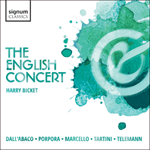Eighteenth-century opera owes much to its most celebrated teacher of singing, Nicola Porpora (born Naples 1686, died Naples 1768), not least because his restless nature led him several times to Venice, twice to Vienna, to Dresden and to London—all Europe thus learned of his grand style of vocalization. Vienna in 1725 was not a success because the Emperor Charles VI disliked florid and profuse ornamentation, but in Dresden Porpora was warmly received. In London for seven years, until 1737, he was director of the opera house established in opposition to that presided over by Handel. His compositions are basically contrapuntal but the thematic material is highly ornamental, derived of course from contemporary operatic style. The cello is the virtuoso singer in this concerto, although its tenor voice is often involved directly in the musical texture. Both Allegros, the first being a double fugue, feature florid passage-work while the melody of the slow movements is developed contrapuntally.
from notes by Hyperion Records Ltd © 1988
L’opéra du XVIIIe siècle doit beaucoup à son plus célèbre professeur de chant, Nicola Porpora (Naples, 1686– Naples, 1768), que sa nature agitée entraîna plusieurs fois à Venise, mais aussi deux fois à Vienne, Dresde et Londres— toute l’Europe s’initia ainsi à son grandiose style de vocalisation. Vienne, en 1725, ne lui fit pas un triomphe, car l’empereur Charles VI détestait l’ornementation fleurie et profuse, mais Dresde lui réserva un accueil chaleureux. Londres lui confia, durant sept ans, la direction de l’opéra établi pour concurrencer la maison présidée par Haendel. Ses compositions sont fondamentalement contrapuntiques mais leur matériau thématique, extrêmement ornemental, provient naturellement du style opératique contemporain. Le violoncelle est le chanteur virtuose du présent concerto, même si sa voix de ténor est souvent impliquée directement dans la texture musicale. Les deux Allegros, dont le premier est une double fugue, mettent en scène un passage fleuri, cependant que la mélodie des mouvements lents connaît un développement contrapuntique.
extrait des notes rédigées par Hyperion Records Ltd © 1988
Die Oper des 18. Jahrhunderts hat ihrem berühmtesten Gesangslehrer Nicola Porpora (geb. 1686 und gest. 1768 in Neapel) vieles zu verdanken, nicht zuletzt deshalb, weil sein rastloses Wesen ihn mehrmals nach Venedig, zweimal nach Wien, außerdem nach Dresden und London führte—ganz Europa kam so in den Genuß seines glanzvollen Gesangsstils. Der Aufenthalt 1725 in Wien war kein Erfolg, da Kaiser Karl VI. eine Abneigung gegen schwülstige und verschwenderische Ornamentierung hatte, aber in Dresden wurde Porpora freundlich aufgenommen. In London war er sieben Jahre lang (bis 1737) Direktor des Opernhauses, das in Opposition zu dem von Händel geleiteten gegründet worden war. Seine Kompositionen sind im wesentlichen kontrapunktisch angelegt, doch das Themenmaterial ist hochverziert, was natürlich auf den Opernstil jener Zeit zurückgeht. Das Cello ist der virtuose Gesangssolist dieses Konzerts, auch wenn seine Tenorstimme oft direkt mit der Struktur der Musik verwoben ist. Beide Allegri, deren erstes eine Doppelfuge ist, bestechen durch blumiges Passaggio, während die Melodie der langsamen Sätze kontrapunktisch entwickelt wird.
aus dem Begleittext von Hyperion Records Ltd © 1988
L’opera del ’700 deve molto a questo famosissimo maestro di canto Nicola Porpora (1686–1768), anche perché la sua natura irrequieta lo portò diverse volte a Venezia, due volte a Vienna, a Dresda e a Londra, e tutta Europa ebbe quindi modo di conoscere il suo superbo stile di vocalizzazione. A Vienna nel 1725 non ebbe successo perché l’imperatore Carlo VI aveva in antipatia l’ornato fiorito e copioso, ma a Dresda Porpora ottenne una calda accoglienza. A Londra per sette anni fino al 1737, vi diresse il teatro d’opera fonadato in opposizione a quello capeggiato da Haendel. Nel 1754 fu di nuovo a Vienna e fu maestro del giovane Haydn. Le composizioni di Porpora sono essenzialmente contrappuntistiche, ma il materiale tematico è fortemente ornamentale e deriva naturalmente dallo stile operistico dell’epoca. In questo concerto il virtuoso di canto è il violoncello, anche se la sua voce tenorile viene spesso direttamente coinvolta nella tessitura musicale. Nei due allegri, il primo dei quali è una doppia fuga, si notano i passaggi fioriti, mentre ha uno sviluppo contrappuntistico la melodia dei movimenti lenti.
Hyperion Records Ltd © 1988


 Concerti by Telemann, Tartini & others
Concerti by Telemann, Tartini & others
